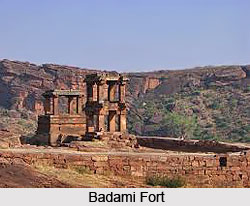 Badami Fort has a rich history of early and the medieval history. Badami, otherwise known as Vatapi, is well renowned for its beautiful and well crafted caves and also for its rock cut temples. Founded in 540 A.D by the great king Pulakeshin of the Chalukyas, it lies north-west of Bangalore at a distance of 500 kms. It comes under the Bagalkot District in Karnataka. It will be ingrained in your memories for long if you enjoy the Dravidian and Nagara form of architecture of the numerous temples present here.
Badami Fort has a rich history of early and the medieval history. Badami, otherwise known as Vatapi, is well renowned for its beautiful and well crafted caves and also for its rock cut temples. Founded in 540 A.D by the great king Pulakeshin of the Chalukyas, it lies north-west of Bangalore at a distance of 500 kms. It comes under the Bagalkot District in Karnataka. It will be ingrained in your memories for long if you enjoy the Dravidian and Nagara form of architecture of the numerous temples present here.
Badami is the site of the 6th-7th century Brahmanical and Jain cave temples. The temples are cut out of solid rock with elaborate interior decorations that speak volumes of art and architecture of that period. There are 4 Badami cave temples connected with each other with a flight of stairs.
History of Badami Fort
It was the Chalukya king Pulakesin I who made Badami, then known as Vatapi, his capital in the year 543AD. His descendents came to be known as the Badami Chalukyas. They expanded the kingdom, bringing most of the Deccan under their rule. During the reign of Pulakeshin II, the kingdom extended from the banks of the Narmada River in the north western part of India, all the way to the banks of the Kaveri River, bordering the Pallava kingdom. The history of the Pallavas and Chalukyas is intertwined with constant wars, victory and defeat. Each dynasty left behind the marks of its invasions, and each dynasty gained and lost treasures.
The golden period of Badami ended in 642 AD when the Pallava king Narasimhavarman attacked and occupied the city. It was only after 13 years of occupation that Badami was liberated again by the Chalukya king Vikramaditya I.
Badami once a royal capital of the Chalukyas is now a sleepy town in Bagalkot district of Karnataka. The town was known as Vatapi previously. It is settled in a valley at the base of a furrowed, red arenaceous rock that rings Agastya Lake. Badami is a place which is full of cave temples, entryways, fortresses, dedications and carvings.
The Chalukyas who had ruled Karnataka and Andhra Pradesh during 6th and 8th centuries had Badami as their capital. The greatest among the Chalukyas was Pulakeshi II who ruled between the genres 610-642 AD. He defeated many kings and Mahendra Verman I, the Pallava king, was one among them. The state was founded by him in 540 AD. The ancient Chalukyas of Badami are accredited with some of the best customs of Dravidian architecture admitting an observational fuse of older South Indian temple construction and ornamentation and the Nagara mode of North India. This beautiful blend of south and north passed on into the Dravidian temple building pattern.



















